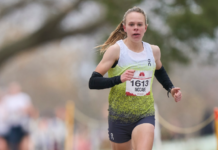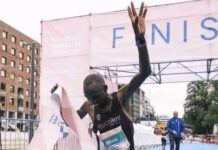© Copyright – 2025 – Athletics Illustrated
World Athletics has released its final two choices for the Athletes of the Year award in each of the three men’s and women’s categories.
The categories are for “track,” “field,” and “out-of-stadium” athletes of the year. The list below makes sense; however, the female track athlete of the year is a mystery, as the Netherlands’ Femke Bol and the USA’s Sydney McLaughlin-Levrone are the final two. Are they really the two best?
Finalists
Women’s track athlete of the year
Femke Bol (NED) – world 400m hurdles champion
Sydney McLaughlin-Levrone (USA) – world 400m champion
Men’s track athlete of the year
Noah Lyles (USA) – world 200m champion
Emmanuel Wanyonyi (KEN) – world 800m champion
Women’s field athlete of the year
Tara Davis-Woodhall (USA) – world long jump champion
Nicola Olyslagers (AUS) – world high jump champion
Men’s field athlete of the year
Mondo Duplantis (SWE) – world pole vault champion
Mattia Furlani (ITA) – world long jump champion
Women’s out-of-stadium athlete of the year
Peres Jepchirchir (KEN) – world marathon champion
Maria Perez (ESP) – world 20km and 35km race walk champion
Men’s out-of-stadium athlete of the year
Sabastian Sawe (KEN) – London Marathon and Berlin Marathon champion
Alphonce Simbu (TAN) – world marathon champion
The Athletes of the Year in each category, as well as the overall winners, will be revealed at a ceremony in Monaco on Sunday, 30 November, as part of the World Athletics Awards 2025.
Who is missing?
Next to each athlete’s name are their respective single accomplishments achieved during 2025. For example, Bol is the 2025 Tokyo World Athletics Champion in the 400 metre hurdles event. Meanwhile, McLaughlin-Levrone is the 400m champion.

The first names that come to mind who may be missing are Beatrice Chebet and Faith Kipyegon from Kenya, and American sprinter Melissa Jefferson-Wooden. Unlike Bol and McLaughlin-Levrone, Chebet won not one, but two gold medals at the Tokyo World Championships. She won in both the 5000m and 10,000m events. Also, the 25-year-old set a world record in 2025. Neither Bol nor McLaughlin-Levrone accomplished a world record in 2025. While McLaughlin-Levrone holds the world record for the 400m hurdles, she set it in 2024.
Bol and McLaughlin-Levrone hold several Area Records, “European” and “North American,” respectively. Both are great athletes and are deserving of votes, but Chebet accomplished much more in the calendar year of 2025.
Chebet’s year
Four times she won Diamond League races over 3000m and 5000m.
Chebet is the first female to run the 5000m distance under the 14-minute benchmark. She ran 13:58.06 for the new world record at the Prefontaine Classic in July. Chebet’s 10,000m world record performance (from 2024) is worth 1309 points on the World Athletics’ own points performance rating system. While the World Athletics points system is not perfect, it provides a very good idea of where a performance stands amongst other distances and disciplines.
Perhaps the 1286 points that her 5000m performance was not noteworthy enough.
Kelvin Kiptum’s marathon world record of 2:00:35 is rated at 1307 pts.
Ruth Chepngetich’s marathon world record is valued at 1312 points. While the Kenyan was suspended for doping, the world record remains. This is the information we have to work with.
In head-to-head competition, Chebet won eight of 11 events. She finished second and third in two of them. The second-place finish was in the 1500m event, where she clocked a world-class 3:54.73, which is not in her typical range of distances. She ran that race at the Silesia Kamila Skolimowska Memorial, Stadion Śląski in Chorzów, Poland, on August 16.
Melissa Jefferson-Wooden
Melissa Jefferson-Wooden won three gold medals at the 2025 Tokyo World Athletics Championships. She dominated the 100m, 200m and the 4 x 100m events.
Jefferson-Wooden ran as fast as 10.61 and 21.68 this season.
Only two athletes in history have run faster than 10.61. They are Elaine Thompson-Herah from Jamaica with her 10.54 and fellow Jamaican Shelly-Ann Fraser-Pryce with her PB of 10.60. Next is a three-way tie at 10.61 with Florence Griffith-Joyner and Thompson-Herah.
The 24-year-old won the national championships in all three events, as well as all three Diamond League meets that she competed in. Only six athletes have run faster in the 200m. Two of whom are suspected dopers, Florence Griffith-Joyner and Marion Jones. Jones was implicated in the BALCO scandal and later admitted to using a designer drug called “the clear.”
Based on whatever criteria were used to narrow down Noah Lyles to a finalist, they should apply to Jefferson-Wooden. He did win the 200m gold at the Tokyo World Championships; however, by his standards had a sub-par 2025. A favourite to win the 100m, he finished third.
In comparison, Jefferson-Wooden had a better year.
While sprinters can race much more often than long-distance runners, Chebet put in a big year over a long period of time. While sprinters are more likely to have sudden, catastrophic injuries, distance runners need time to recover, from a cardiovascular perspective.
Chebet and Jefferson-Wooden deserve the finalist position more than Bol does.
While Bol is a great talent, has a likable personality and is a good sportsperson, the results speak for themselves.
Faith Kipyegon
Kenyan Faith Kipyegon won the 1500m gold medal at the 2025 Tokyo World Athletics Championships. She also broke the world record in the distance in 2025. The 31-year-old clocked a 3:48.68 during the Prefontaine Classic.
She is the only athlete to run sub-3:50 in the metric mile, having done so three times during her career.
Also, in 2025, Kipyegon ran the African record in the 3000m distance, clocking an 8:07.04 performance.
She is the four-time world champion at the distance and three-time Olympic champion.
Selection process
While World Athletics or any governing body cannot be blamed for choosing Bol and McLaughlin-Levrone, arriving at the choice leaves out three performers who are at least, if not more, deserving.
The World Athletics Athlete of the Year is chosen through a multi-stage process that includes votes from the World Athletics Council, the World Athletics Family, and public fan votes via social media and the World Athletics+ platform. The criteria are not explicitly stated, but the selection process is based on performances throughout the competitive season across track, field, and out-of-stadium events.
Finalist selection
Voting sources: A three-way vote determines the finalists for each category (Track, Field, Out-of-Stadium).
World Athletics Council vote (50%)
World Athletics Family vote (25%)
Public vote via social media (25%)
Social media voting: A “like” on Facebook or Instagram or a repost on X counts as one vote.
Finalists: The top two athletes in each category from this initial round become finalists.
Overall award winner selection
Final fan vote: After finalists are determined, a final fan vote takes place on the World Athletics+ platform for registered users to select the overall winners.
Categories: The overall male and female World Athletes of the Year are chosen from the winners of the Track, Field, and Out-of-Stadium categories.
Performance criteria
While official criteria are not detailed publicly, the selection is based on athletes’ performances throughout the competitive season.
The nominations and final selections are based on performances in major events like the Olympics and World Championships, as well as other major competitions.
The nominations for the different categories (Track, Field, Out-of-Stadium) highlight standout performances across all disciplines.
Based on the criteria listed above, what we do know is that performance at major competitions is the primary focus. What we don’t know, we don’t know. So, questions remain. Is Bol better for the sport because she represents the Netherlands and not an athletics superpower like Kenya, USA, or Ethiopia, for example?
Are Bol and McLaughlin-Levrone better for the sport because they are good in the media? They are well-liked and attract people to stadiums, they interview well, are good on social media and present favourably. They are indeed great athletes.
On the other hand, Chebet represents Kenya, which is a country on the WADA watch list for doping. She is represented by Frederico Rosa, who has been challenged in court over many of his athletes who have tested positive for doping. Chebet is so good, perhaps she is too good as she is the first female to run under the benchmarks of 14 in the 5 km road race, 14 in the 5000m and 29 minutes in the 10,000m.















